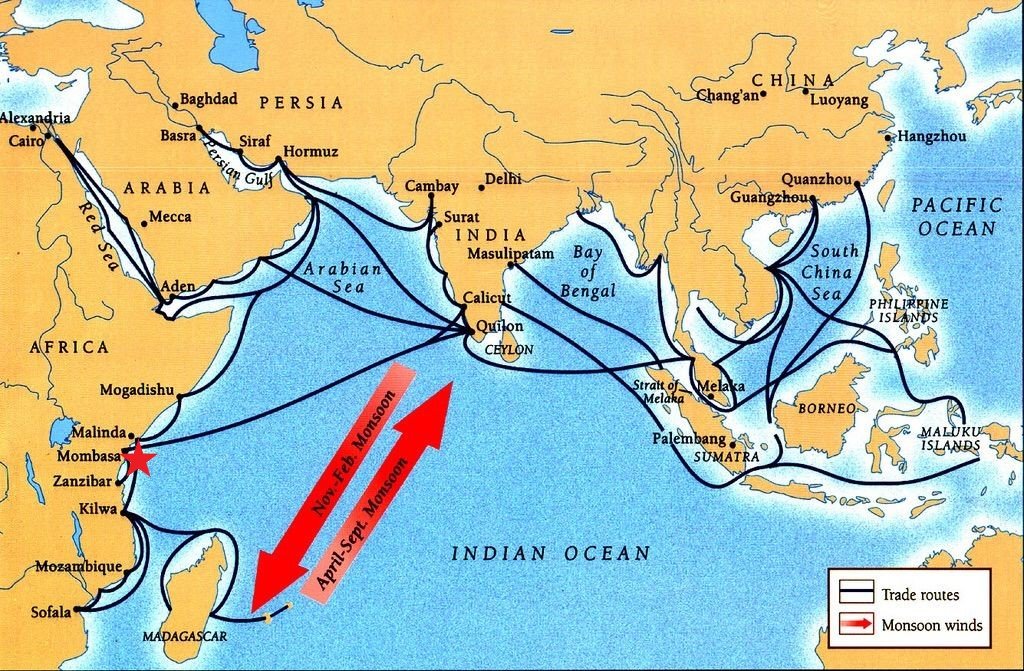What I learned from two mosques in Mombasa
Indian ocean trade routes, with Mombasa marked with a red star
The Kenyan city of Mombasa has been an important port city for over 2000 years, connecting Africa to the Middle East, India, and China.
I visited for a couple days in February, and on a whim bought a book on Swahili architecture. I was struck by how much I could learn about the city just from learning about two mosques (1).
Mnara Mosque (also called Basheikh/Tangana). In a back alley, not clearly labeled, and you would miss it if you weren’t specifically looking for it
Mandhry Mosque - still powerlines but on a main thoroughfare. Has a gift shop attached, not visible here.
More modern Konzi Mosque in Mombasa, It’s not as much in the Swahili style and does not have the rounded Swahili-style tower
1. Swahili architecture is distinctly African - not just imported Arab culture. British colonialists claimed that Swahili architecture was simply Arab (the implication being that Africans did not have such advanced culture). It is certainly Arab-influenced, but it has core features that come from building history on the African continent. This is illustrated by the minarets (towers) on these two mosques - they are simple, rounded, white, and very solid. There are four mosques with minarets like this in the world - all of them on the Swahili coast: 2 in Mombasa, 1 in Lamu (Kenya), and one in Stone Town (Zanzibar, part of Tanzania) (1).
For example, see the picture of a non-Swahili mosque in Mombasa for reference. The tower looks quite different.
2. British colonizers wanted to give prominence to the “Arab” factions rather than the “African” factions in Mombasa. The mosques were given attention and prominence accordingly: The Mnara mosque was more associated with Swahili people, while the Mandhry was more associated with Arabs. I’m sure there are other factors as well, but this seems like it has trickled down to today where the Mandhry mosque is labeled as a great tourist site, with a gift shop, while the Mnara mosque is not well-labeled and is hard to find (1).
3. Islam was super culturally important in Indian ocean trade. Indian Ocean trade was dominated by Muslim merchants, and mosques in a port city would serve as a beacon to arriving travelers. The Mandhry mosque was one of the most prominent buildings on the Mombasa coast, and was available to Muslim visitors as a place to rest, and even sleep.
I had never really appreciated architecture as a lens for learning about history and culture, but I’m sold now (2). I think that this lens might be especially valuable in African cultures. I’ve found fewer analytical, interesting, well-researched writing on Kenyan culture/history/art compared to other foreign countries I’ve tried to learn about (China, Japan, India, Persia). My guess is that this is partly because there hasn't been written culture in east Africa as long, so there aren’t written records to dive into. But buildings have existed for a long time, which gives architectural study a comparative advantage.
That’s my hypothesis anyways. I’m now paying much more attention to the architecture of the places I visit to try to understand the place and people in a different way (3).
—
1. Unfortunately I couldn’t see the thing I most wanted to see in Mombasa, which is the alley that Cob gets stuck in in Inception. As I learned 2 days before departing, that chase sequence was actually shot in Tangier Morocco
2. Anecdotally, it seems factionalism is still a significant factor in Mombasa - as my guide was taking me around he specifically pointed out how “this mosque is Shi’ite”, “this mosque is Sunni”, and when prompted that another mosque was for Indian muslims.
3. I was convinced by this one experience to buy a couple volumes of the Sub-Saharan Africa Architectural Guide (h/t Tyler Cowen).



